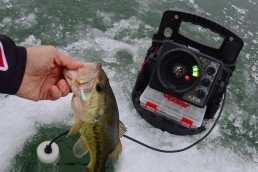Customizing Ice-fishing Lures is Fun and Rewarding
SHARE THIS POST
With the waterfowling season coming close to an end and the outdoors shows going into full swing, one still might have the need to do something else to kick that old cabin fever. I’ve enjoyed a couple nice ice fishing trips at this time of year. As odd as it may sound, this warm-weather guy is really getting into walking on hard water and fishing for ‘gills through the ice.
The headlines on the front page of the glossy covered outdoor magazines caught my eye the other day. It was about catching big ‘gills. It really peaked my interest with one article that showed you how to modify ice lures so that they’ll catch big monster, hump-backed bull bluegills. I think some extreme editorial license was used here in the description, but I still found the article interesting.
I studied the article, looked at the photos and then went to my ice tackle box to see what was there. Much to my surprise, everything the author wrote about was in the box—it suddenly dawns upon me that I can do this.
Now I’m not trying to take the wind out of his sails nor will I claim that these ideas are all mine. But this did get me thinking and coming up with a few of my own ice fishing ideas. In particular, my thoughts are how to make an extremely light lure and give it a little different profile, and a bit more weight so it’s easier to use.
All that you need to customize some jigs is a nicely painted, very small lead or tungsten ice jig and a small metal ice fishing jigging spoon.
Jigging ice spoons normally come with a small treble hook. Many have lead or the metal is just heavy. I’m talking about the really light ones.
The hook must be removed by detaching it from the split ring. Once that’s off, slip on the ice jig. Basically, what you’ll have is the flash of the spoon and the profile and weight of the jig below it where you would attach a waxworm or two.
On a personal note, I used live waxworms and Berkley Gulp Alive waxies. For me they seem to produce fish just about the same. The big difference is that the Gulp bait lasts until it’s gone; it doesn’t die or turn black in a few days.
So making a modified bait seemed simple enough to do. And it really is. But there are a few problems in putting a rig like this together.
Are you enjoying this post?
You can be among the first to get the latest info on where to go, what to use and how to use it!
Try to remember that these are ice fishing jigs and spoons. That means that they are small—very small. Regular spilt ring pliers just don’t work on these because the ring is so tiny. I’m sure someone makes a pair of pliers small enough for them, but I don’t have one.
If you are one who bites your nails, forget about this rig, you’ll never get one put together. I wedged my thumb nail into the split ring to separate it to twist the treble hook almost all the way off. With the ring opening, I’ll put the jig on behind the hook. From there I twist and turn the ring until the hook works its way off and the jig is all the way on. It isn’t easy but it works. Couple that with these old and tired eyes of mine and it made it a challenge, but it worked.
If you have one of those magnifying lamps with the circular florescent bulb, it would be a lot easier. Working with the tiny spoon and jig was difficult and took way too much time. However, I did get it put together and it looks just like the rig in the magazine. I’ll say this: If you make a jig or customize one to any pattern you want, and catch fish, your efforts are well worth it.
I was anxious to try it out. Even though the temperatures were below freezing, it didn’t stop me from taking up an invitation to fish a pond out by Seneca. I had my ice rod with 2-pound-test line on the reel and my little custom jigging spoon tied on.
If you have a flasher, use it to watch were the jig falls. A 59-cent depth finder can be put on the jigging spoon and dropped to the bottom of the pond. Mark the depth with a slip bobber knot so you can work this spoon about 12 inches off the bottom. With the sliding knot set at a certain point on the line, you’ll always know right where the jig is working.
The jigging action must have been a bit too aggressive at first. Although I was quite pleased to see that a nice-sized bluegill took the bait within only a few minutes, consistent action was not there. After a short while, the light but constant jigging action changed to raising the rod about 1/2 foot and slowing it and letting it drop. After about three repetitions, I would just hold the rod still for what seemed like forever. It was only about 20 seconds though. So it was jig, stop, jig, stop. And it worked.
The rig worked as well as it was written about (in the article). That’s the neat part. Will I be building more jigs like this? Probably not. But then, maybe I’ll try a few more. I may be loosing my patience to work on meticulous little things like this, but I am glad that I did it. It was a good experience to catch some fish with an altered bait. When you try something a little different, you’ll find that Great fishing is not that far away.
Visit Don Dziedzina’s Blog at www.illinoisoutdoors.com.
Don Dziedzina shows a nice ‘gill caught with an altered store-bought ice fishing spoon.
MWO
SHARE THIS POST
Did you enjoy this post?
You can be among the first to get the latest info on where to go, what to use and how to use it!
Don Dziedzina
MidWest Outdoors works with more than 200 outdoor experts each year, who contribute articles based on their areas of expertise. MidWest Outdoors magazine offers more fishing and hunting articles than any other publication!



